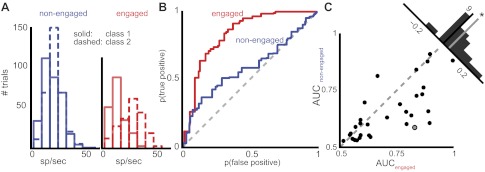Fig. 6.

CM neurons have a greater ability to discriminate between behavioral classes when birds are engaged in a task. A: distribution of firing rates for an example neuron in both the nonengaged (left) and engaged (right) conditions. Solid lines indicate the distribution of firing rates to class 1 stimuli, and dashed lines indicate the distribution of firing rates for class 2 stimuli. By eye, one can observe a greater separation in the distributions in the engaged condition. This difference is better described by the receiver operating characteristic curve (ROC) in B, where the false positive rate is plotted against the true positive rate at different thresholds in each condition. The area under the curve (AUC) is larger for the red curve, indicating that there is more discriminability between class 1 and class 2 firing rates for this neuron in the engaged condition than in the nonengaged condition. C: for all neurons that showed significant discrimination ability in both task engagement conditions, the AUC is plotted in each condition. The distribution of differences (top right, AUCengaged − AUCnonengaged) is significantly greater than zero(*), meaning that neurons show greater discrimination of task-relevant classes when they are engaged in a task than when they are passively listening. The gray-centered point indicates the example neuron from A and B.
